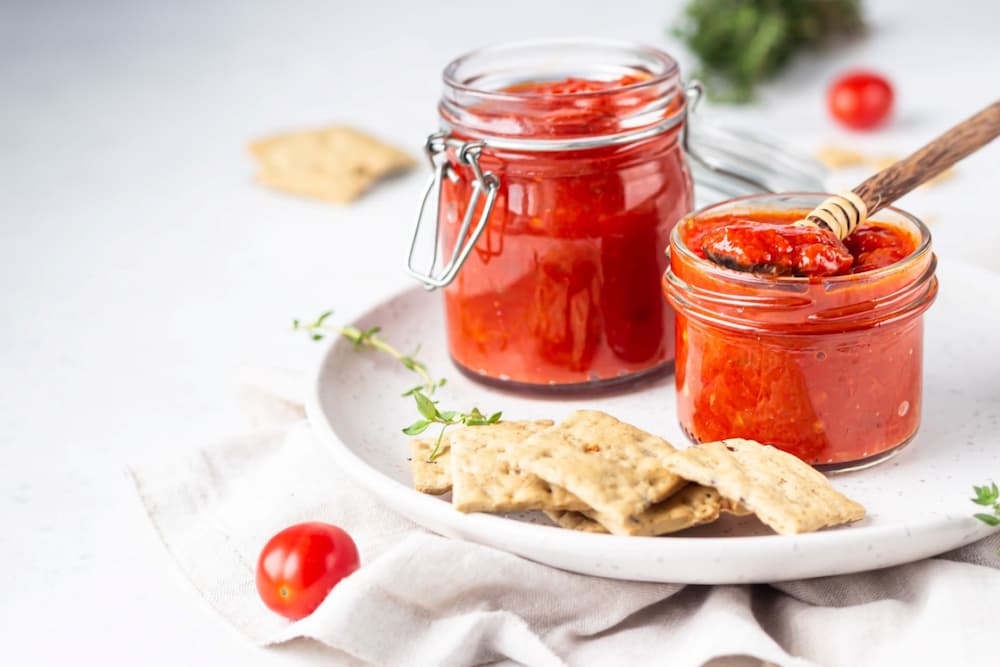Ajvar: The Ultimate Balkan Spread
If you would ask any Balkan resident what the one thing they can eat with every single dish is – they would probably say ajvar.
And it’s no surprise – ajvar is very popular in the Balkans, and people swear by it. It goes even further, and people often fight with each other to see who ate better ajvar in their lifetime.
Why, you may ask? Why is ajvar so crucial to the Balkan people? Many other sauces go even better with specific dishes that are more famous worldwide (ketchup, mustard, or even tartar).
Before we answer this question, you need to realize that ajvar has a special place in the hearts of every Balkan person and that they are often very subjective on this matter.
Balkan residents just love ajvar and practically take it personally when someone (who never tried ajvar before) tells them they don’t like it.
And this goes way beyond the objective quality of the sauce. We may argue that there are better condiments out there, but what we can’t argue about is that ajvar has one secret ingredient – the love of the Balkan people.
So, let this article be your go-to guide when it comes to ajvar. Maybe you heard about it from your Balkan friend, or you tried it somewhere and want to know more.
Whatever the case might be, in this article, we’ll cover everything there is to ajvar – what it is, how it’s made, its history, and possible alternative you can use (but let’s face it, original is always better).
What is Ajvar?
First and foremost, let’s talk about what ajvar is. It’s often hard to explain this to someone who doesn’t come from the Balkan countries, but we’ll try to be as transparent as possible.
Ajvar is a condiment (a sauce or a spice) explicitly made from sweet red peppers and eggplants. If we’re talking about homemade ajvar, it’s often made of roasted red peppers and has a slightly different taste.
Ajvar became extremely popular throughout Yugoslavia after World War II – because it was easy to make and could mix with almost every dish that was common for traditional households.
The love towards ajvar grew as time passed, and even people in Greece and Eastern countries such as Russia recognized its quality and fantastic taste.
Ajvar is present almost everywhere, and some companies distribute it in the whole world. In western countries such as the US or Canada, it’s often considered a premium condiment.
Depending on the number of peppers and eggplants, there are different variants of ajvar. It can be traditional (sweet), piquant (the most common), or extremely hot.
We forgot to mention chili peppers – another ingredient that is almost always present in ajvar. Balkan people like their dishes hot, so that’s why they put chili in virtually any meal – especially ajvar.

Fun fact – “Homemade Leskovac Ajvar” and “Macedonian Ajvar” are registered in the World Intellectual Property Organization, and their names are protected as a brand.
Although ajvar is typical for Balkan countries, we have to give some credit to Turks for it. Many Balkan countries were under Turkish influence in the past, and therefore, some Turkish names stayed present. Ajvar is one of them.
Its name comes from the Turkish word “havyar.” Translated, “havyar” means “salted roe or caviar.”
Yeah, we know. Ajvar doesn’t have a lot in common with caviar, but hey, if you ask someone in the Balkans what they would choose between ajvar and caviar, we think we know what the answer would be.
When we said that ajvar could be mixed with many meals, we didn’t lie. It can go with almost all types of meat, mezze (a starter meal in the Balkan countries that contains “prosciutto (type of meat) and cheese,” and even pizza.
People have their preferences, and they mix ajvar with whatever they like. Ajvar goes along with any type of pastry as well.
How to make Ajvar at home
Now that you know the basics of ajvar let’s cover a straightforward recipe that can help you make ajvar in the comfort of your own home.
You can always opt for buying one from the store, but there’s just something about making one of your own that carries a sense of accomplishment and pride.
Read also: 4 Different Ways to Cook Cevapi
First, you’ll need red peppers as the main ingredient for ajvar. Pick the ones which look full, bright red, and healthy.
Next, roast them on a plate carefully, and make sure that every side is evenly roasted. You can do this on an open fire, on a stove, or in an oven.
When this is done, leave the peppers to cool off. This is important because we want the skin of the pepper to separate from the “flesh”.
Then, carefully peel off the skin and remove any seeds that you see.
The next step is essential, as you need to ground the peppers in a mill. If you don’t have a mill, you can cut the peppers into small pieces.
The mush that you end up with is then stewed for several hours. Yeah, we know – this might be tiring. But, the more you stew, the better.
This is done in large pots, and as a cherry on top, you can add a bit of sunflower oil (to reduce the water and increase preservation later on) together with a little bit of salt.
The hot mush is then placed in individual glass jars where it stays until you decide that you want to eat it and enjoy a good meal.
Ajvar substitutes
Pindjur is the main ajvar substitute, having almost the same texture and taste. The critical difference between the two is the way the peppers are prepared – in ajvar, they are ground, while in pindjur, they are cut into small pieces.
People also create their ajvar substitutes. Since all peppers are so versatile, they can be prepared differently and add a whole new dimension to the condiment. One can also add balsamico, onions, or yellow pepper to spice things up.
All of this means that you can make your version of ajvar – in any way you like. Ajvar is unique, and as it is, there is no perfect alternative.
But, if you are missing something (eggplants, for example), it’s not a big deal. You can always put something else and create an alternative of your own.
Is Ajvar healthy?
Generally speaking, ajvar is considered to be healthy. The ingredients that go in are all-natural and don’t contain any negative parts that can damage your health.
If you want to make ajvar even more beneficial, we suggest that you ditch the salt and make it without it. In most cases, extra salt can be bad.
Ajvar can also be vegan and gluten-free, depending on the ingredients that you use. In most cases, you’ll only be using healthy veggies.
But, as with everything, don’t overdo it. Although ajvar generally is healthy, eating too much of it (and too often) can be bad for you.
Conclusion
After reading this article, we hope that you learned something new about ajvar and why it’s so popular in the Balkan countries. It’s one of a kind, and only if you try it, you’ll know why it’s so special.
Making homemade ajvar is easy, and if you want to spice things up for your Sunday lunch, we highly suggest that you roll up your sleeves and get to work.
It’s going to be fun, and at the same time, you’ll end up with a ton of ajvar – which you can use for months afterward! Is there anything better than that?
And don’t forget, if you want to taste true homemade Balkan ajvar, you can always try it at Ambar!
